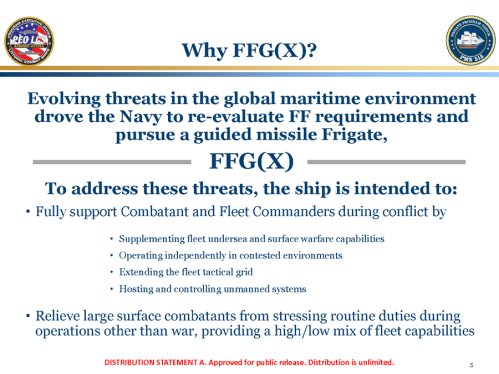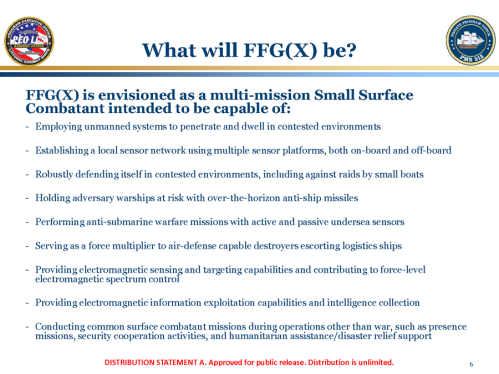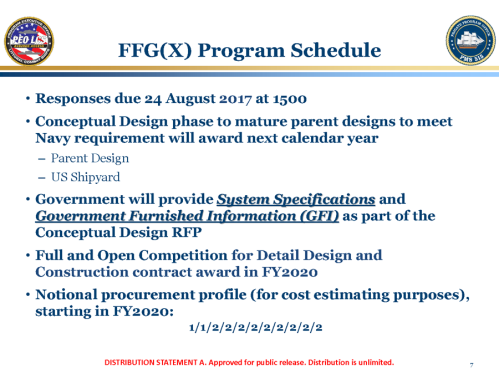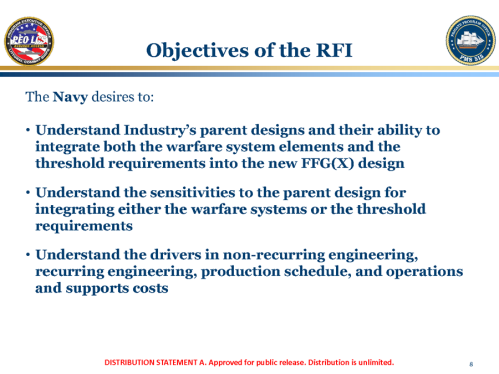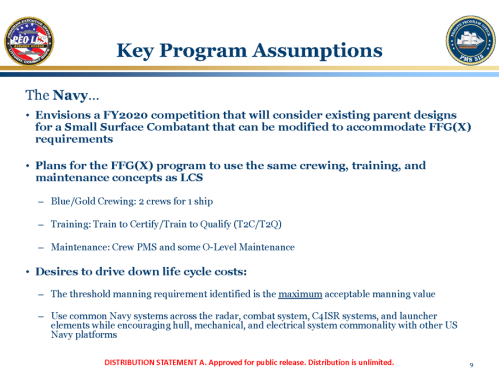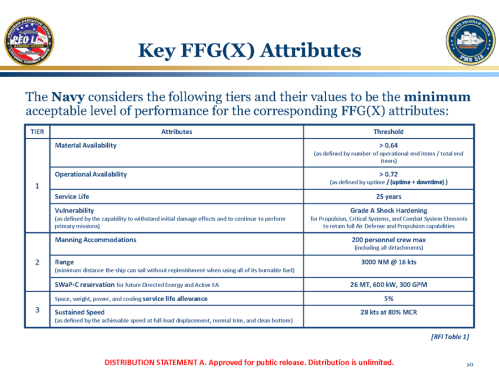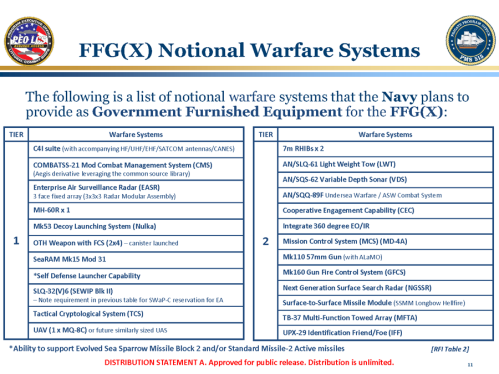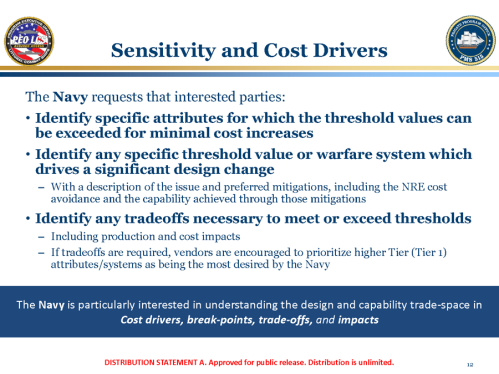Introduction
This report provides background information and discusses potential issues for Congress regarding the Navy's FFG(X) program, a program to procure a new class of 20 guided-missile frigates (FFGs). The FFG(X) program was initiated as part of the Navy's FY2018 budget submission. The Navy wants to procure the first FFG(X) in FY2020. The Navy's proposed FY2018 budget requests $143.5 million in research and development funding for the program.
The FFG(X) program presents several potential oversight issues for Congress. Congress's decisions on the program could affect Navy capabilities and funding requirements and the shipbuilding industrial base.
This report focuses on the FFG(X) program. A related Navy shipbuilding program, the Littoral Combat Ship (LCS) program, is covered in a separate CRS report.1 Other CRS reports discuss the strategic context within which the FFG(X) program and other Navy acquisition programs may be considered.2
Background
U.S. Navy Surface Combatants in General
U.S. Navy surface combatants are multimission ships equipped to conduct various peacetime and wartime missions. The Navy's large surface combatants include guided-missile cruisers (CGs) and guided-missile destroyers (DDGs).3 The Navy's small surface combatants include patrol craft, mine warfare ships,4 Littoral Combat Ships (LCSs), and frigates.5 LCSs might be thought of as light frigates (FFLs) or corvettes, which are terms used to refer to ships that are bigger than patrol craft and smaller than frigates.
U.S. Navy Frigates in General
U.S. Navy frigates are smaller, less capable, and less expensive to procure and operate than U.S. Navy destroyers and cruisers. In contrast to cruisers and destroyers, which are designed to operate in higher-threat areas, frigates are generally intended to operate more in lower-threat areas. U.S. Navy frigates perform many of the same peacetime and wartime missions as U.S. Navy cruisers and destroyers, but since frigates are intended to do so in lower-threat areas, they are equipped with fewer weapons, less-capable radars and other systems, and less engineering redundancy and survivability than cruisers and destroyers.
Compared to cruisers and destroyers, frigates can be a more cost-effective way to perform missions that do not require the use of a higher-cost cruiser or destroyer. In the past, the Navy's combined force of higher-capability, higher-cost cruisers and destroyers and lower-capability, lower-cost frigates has been referred to as an example of a so-called high-low force mix. High-low mixes have been used by the Navy and the other military services in recent decades as a means of balancing desires for individual platform capability against desires for platform numbers in a context of varied missions and finite resources.
Peacetime missions performed by frigates can include, among other things, engagement with allied and partner navies, maritime security operations (such as anti-piracy operations), and humanitarian assistance and disaster response (HA/DR) operations. Intended wartime operations of frigates include escorting (i.e., protecting) military supply and transport ships and civilian cargo ships that are moving through potentially dangerous waters. In support of intended wartime operations, frigates are designed to conduct anti-air warfare (AAW—aka air defense) operations, anti-surface warfare (ASuW) operations (meaning operations against enemy surface ships and craft), and antisubmarine warfare (ASW) operations. U.S. Navy frigates are designed to operate in larger Navy formations or as solitary ships. Operations as solitary ships can include the peacetime operations mentioned above.
The most recent class of frigates operated by the Navy was the Oliver Hazard Perry (FFG-7) class (Figure 1). A total of 51 FFG-7 class ships were procured between FY1973 and FY1984. The ships entered service between 1977 and 1989, and were decommissioned between 1994 and 2015.6 In their final configuration, the ships were about 455 feet long and had full load displacements of roughly 3,900 tons to 4,100 tons. (By comparison, the Navy's Arleigh Burke [DDG-51] class destroyers are about 510 feet long and have full load displacements of roughly 9,300 tons.)7 Following their decommissioning, a number of FFG-7 class ships, like certain other decommissioned U.S. Navy ships, have been transferred to the navies of U.S. allied and partner countries.
Small Surface Combatant Force Level
Force-Level Goal
The U.S. Navy's force-level goal, released in December 2016, calls for achieving and maintaining a fleet of 355 ships, including 104 large surface combatants (i.e., cruisers and destroyers) and 52 small surface combatants.8 Although patrol craft are small surface combatants, the 52-ship force-level goal for small surface combatants refers specifically to the total number of frigates, LCSs, and mine warfare ships, excluding patrol craft.9
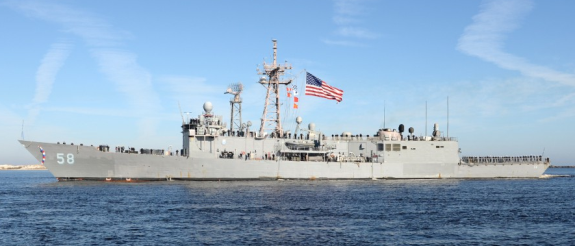 |
|
Source: Photograph accompanying Dave Werner, "Fighting Forward: Last Oliver Perry Class Frigate Deployment," Navy Live, January 5, 2015, accessed September 21, 2017, at http://navylive.dodlive.mil/2015/01/05/fighting-forward-last-oliver-perry-class-frigate-deployment/. |
Current Force Level
Following the decommissioning of the FFG-7 class ships, the Navy's inventory of small surface combatants has been well below the 52-ship force-level goal for small surface combatants. At the end of FY2017, the Navy had 24 small surface combatants, including 13 LCSs, 11 mine warfare ships, and no frigates. At the end of FY2018, the Navy projects it will have 28 small surface combatants, including 17 LCSs, 11 mine warfare ships, and no frigates. In FY2019 and subsequent years, the number of LCSs is to continue to grow toward a total of about 32, and the mine warfare ships are to be decommissioned.
Navy FFG(X) Program10
Meaning of Designation FFG(X)
In the program designation FFG(X), FF means frigate,11 G means guided-missile ship (indicating a ship equipped with an area-defense AAW system),12 and (X) indicates that the design of the ship has not yet been determined. FFG(X) thus means a guided-missile frigate whose design has not yet been determined.13
Program Origin
The FFG(X) program can be viewed as an outgrowth of the LCS program, as follows:
- Prior to a restructuring of the LCS program that was directed in February 2014 by then-Secretary of Defense Chuck Hagel, the LCS program included a planned procurement of 52 LCSs.
- The February 2014 restructuring changed the LCS program into one for procuring 32 LCSs and 20 FFs.
- A second program restructuring that was directed in December 2015 by then-Secretary of Defense Ashton Carter reduced the program's total planned procurement to 40 ships, to consist of either 28 LCSs and 12 FFs, or 30 LCSs and 10 FFs, depending on exactly when production would shift from LCSs to FFs. The FFs were to be built to a modified version of one of the two existing LCS designs.
- As part of its FY2018 budget submission, the Navy restructured the frigate part of this acquisition effort into a freestanding program for procuring an FFG rather than an FF. Under this restructured approach, the FFGs are to be built to either a modified version of one of the two existing LCS designs or a modified version of a different existing U.S. or foreign ship design.
At a May 3, 2017, hearing on the LCS and FFG(X) programs before the Seapower and Projection Forces subcommittee of the House Armed Services Committee, the Navy testified that
As maritime threats have evolved, the Navy is placing greater emphasis on distributed operations, highlighting the need for a full complement of SSCs [small surface combatants] and increasing the need for a Frigate with improved lethality and survivability. The Navy is defining the requirements for the Frigate to improve its ability to operate in a more contested environment than LCS, enhancing its role in distributed maritime operations. In this role, both LCS and Frigate will free up our large surface combatants to focus on their primary missions including area air defense, land strike, and ballistic missile defense. The Navy is also seeking to leverage Fleet-wide commonality of combat system elements wherever possible to deliver capability and flexibility in the most cost effective manner.
To accomplish this, the Navy has established a Frigate Requirement Evaluation Team to update the previous Frigate analysis performed in 2014 and investigate the feasibility of incorporating additional capabilities and enhanced survivability features into the current Frigate designs, as well as explore other hull forms. The results of this analysis will inform the top level Frigate requirements based on cost and capability trades involved. The Navy's revised acquisition strategy is under development and will ensure designs are mature prior to entering into a detail design and construction (DD&C) contract. The Navy will engage with industry in order to support an aggressive conceptual design effort, leading to a Request for Proposals to award the DD&C contract in FY 2020.
As we work through the requirements and acquisition processes for the Frigate, we will endeavor to transition from LCS to Frigate in a manner that maximizes the competitive field for our shipbuilding industrial base. We understand the potential implications of future acquisition strategies to our shipyards and their workforces, and these are considerations we do not take lightly. We are committed to delivering increased capability to our sailors at the best value for the American taxpayer, and that includes maintaining a competitive and healthy industrial base.14
In its FY2018 budget submission, the Navy states the following:
As directed by the Secretary of Defense (SECDEF) in 2014, the Navy via the Small Surface Combatant Task Force (SSCTF) reviewed the capabilities of Littoral Combat Ship (LCS) and explored alternatives to provide a more lethal and survivable ship to meet future missions. The SSCTF recommendations served as the foundation for the revised requirements for the modified LCS (designated as the Frigate (FF)) and an award no later than FY2019. Previous budgets and schedules supported the plan to develop the FF.
As a result of the Navy's 2016 Force Structure Assessment and to address increasingly complex threats in the global maritime environment, the Navy is reassessing the capabilities required to ensure the Frigate paces future threats. The Navy desires to maximize the capability of the future Guided Missile Frigate (FFG(X)) in antisurface warfare (SUW), anti-submarine warfare (ASW) and local air defense (LAD) mission areas, while keeping the ship affordable and part of a "high-low" mix of surface combatants. Our updated assessment will be completed to support finalization of FFG(X) requirements by Spring 2017.15
Program Quantity
A total of 29 LCSs have been procured through FY2017. The Navy's FY2018 budget submission, as amended, requests two more LCSs in FY2018 and projects a request for one final LCS in FY2019. Funding those three ships in FY2018 and FY2019 would make for a total of 32 LCSs. The Navy wants to procure a notional total of 20 FFG(X)s, which in combination with 32 LCSs would meet the Navy's 52-ship force-level goal for small surface combatants.
Procurement Schedule
Following a final year of LCS procurement in FY2019, wants to procure the first FFG(X) in FY2020, the second in FY2021, and the remaining 18 at a rate of two per year in FY2022-FY2030.
Ship Capabilities and Design
As mentioned above, the (X) in the program designation FFG(X) means that the design of the ship has not yet been determined. In general, the Navy envisages the FFG(X) as follows:
- The ship is to be a multimission small surface combatant capable of conducting AAW, ASuW, ASW, and EMW operations.
- Compared to the FF concept that emerged under the February 2014 restructuring of the LCS program, the FFG(X) is to have increased AAW and EMW capability, and enhanced survivability.
- The ship's area-defense AAW system is to be capable of local area AAW, meaning a form of area-defense AAW that extends to a lesser range than the area-defense AAW that can be provided by the Navy's cruisers and destroyers.
- The ship is to be capable of operating in both blue water (i.e., mid-ocean) and littoral (i.e., near-shore) areas.
- The ship is to be capable of operating either independently (when that is appropriate for its assigned mission) or as part of larger Navy formations.
Given the above, the FFG(X) design will likely be larger in terms of displacement, more heavily armed, and more expensive to procure than either the LCS or the FF concept that emerged from the February 2014 LCS program restructuring.
A November 2, 2017, Navy information paper on the combat system to be used by the FFG(X) states the following:
In considering multiple options (Lockheed Martin's COMBATSS-21, General Dynamics' Integrated Combat Management System, and Raytheon's Ship Self Defense System) for the Frigate's Combat Management System (CMS), the following criteria were analyzed:
--Commonality—the degree to which the CMS was common across variants of LCS and the rest of the Navy.
--Performance—demonstrated ability to deliver a certifiable CMS able to meet LCS requirements, with respect to mission area capabilities.
--Cost—the total cost to design, develop, deliver, test and sustain the CMS.
A derivation of the AEGIS combat system widely used throughout the Navy and half of the LCS platforms, the Navy selected COMBATSS-21 as the Frigate CMS. It offered the highest level of commonality, best performance, and lowest cost of the three options.
Similar to the original FF, the primary mission areas for the FFG(X) will be Anti-Submarine Warfare, Surface Warfare, and Electromagnetic Maneuver Warfare. In addition, the FFG(X) will provide upgraded Air Warfare capability and improved lethality and survivability that include a scaled SPY-6 Fixed Array Radar, Standard Missile, Evolved Sea Sparrow Missile, full Surface Electronic Warfare Improvement Program Block 2 capability, and a Cooperative Engagement Capability. The CMS capabilities required to bring these enhancements are already included in Aegis; and thus, they are much simpler to cost effectively incorporate into COMBATSS-21.16
Target Unit Procurement Cost
Follow-On Ships
The Navy wants the follow-on ships in the FFG(X) program (i.e., ships 2 through 20) to have an average unit procurement cost of not more than $950 million each in constant 2018 dollars.17 By way of comparison, the two LCSs that the Navy has requested for FY2018 have an estimated average unit procurement cost of about $568 million each, and the two DDG-51 class destroyers that the Navy has requested for FY2018 have an estimated average unit procurement cost of about $1,750 million each.
On July 10, 2017, the Navy released a Request for Information (RFI) to industry to solicit information for better understanding potential trade-offs between cost and capability in the FFG(X) design.18 On July 25, the Navy continued that effort by holding an industry day event. On July 28, the Navy posted its briefing slides for that event; some of those slides are reprinted in the Appendix.19 Responses to the RFI were due by August 24, 2017. The Navy states that it "received a very robust response to the FFG(X) RFI inclusive of [i.e., including] domestic and foreign ship designs and material vendor solutions."20 The Navy folded information gained through that RFI into its determination of the target unit procurement cost for the FFG(X).
Lead Ship
The Navy has not yet established a target unit procurement cost for the lead ship in the program. The lead ship will be considerably more expensive than the follow-on ships in the program, because the lead ship's procurement cost will incorporate most or all of the detailed design/nonrecurring engineering (DD/NRE) costs for the class. (It is a traditional Navy budgeting practice to attach most or all of the DD/NRE costs for a new ship class to the procurement cost of the lead ship in the class.)
Acquisition Strategy
Parent-Design Approach
The Navy's desire to procure the first FFG(X) in FY2020 does not allow enough time to develop a completely new design (i.e., a clean-sheet design) for the FFG(X). (Using a clean-sheet design might defer the procurement of the first ship to about FY2023.) Consequently, the Navy intends to build the FFG(X) to a modified version of an existing ship design—an approach called the parent-design approach. The parent design could be a U.S. ship design or a foreign ship design.21
Using the parent-design approach can reduce design time and design cost, and can also reduce technical, schedule, and cost risk in building the ship. The Coast Guard and the Navy are currently using the parent-design approach for the Coast Guard's polar icebreaker program.22 The parent-design approach has also been used in the past for other Navy and Coast Guard ships, including Navy mine warfare ships23 and the Coast Guard's new Fast Response Cutters (FRCs).24
No New Technologies or Systems
As an additional measure for reducing technical, schedule, and cost risk in the FFG(X) program, the Navy envisages developing no new technologies or systems for the FFG(X)—the ship is to use systems and technologies that already exist or are already being developed for use in other programs.
Full and Open Competition
The Navy intends to conduct a full and open competition to select the builder of the FFG(X), including proposals based on either U.S. or foreign ship designs. The Navy wants to award multiple conceptual design contracts for the program in FY2018—a November 3, 2017, press report states that the Navy expects to award up to five contracts25—and a detailed design and construction (DD&C) contract for the program in FY2020. Being a recipient of a conceptual design contract is not a requirement for competing for the DD&C contract.
On November 7, 2017, the Navy issued a Request for Proposals (RFP) for the conceptual design contracts. Responses to the RFP are due by December 18, 2017. On October 16, 2017, the Navy posted a presolicitation notice for this RFP that stated the following:
The Naval Sea Systems Command (NAVSEA) intends to issue a full and open competitive solicitation in November 2017 for design development activities to address technical solutions for the Guided Missile Frigate (FFG(X)). The overall objective of this early industry involvement is to enable the Government to reduce FFG(X) risk by maturing industry designs to meet the FFG(X) capability. The Government intends to award multiple contracts resulting from this solicitation....
The competitive solicitation intended for release in November 2017 will provide for Conceptual Design (CD) in accordance with the Government developed FFG(X) System Specification.... All future FFG(X) ship construction shall be conducted in a U.S. shipyard. In order to be eligible for CD, offerors must have a parent design from which to start. A parent design is defined as a design of a ship that has been through production and demonstrated (full scale) at sea. Offerors will only be allowed to submit one proposal as a prime contractor, and each prime contractor will only be eligible for a single award. However, offerors may be subcontractors under a prime in multiple proposals.
On October 20, 2017, the Navy posted an update to the notice stating the following:
The purpose of this update is to provide clarification with respect to the parent design definition and prime contractor requirements noted within the original synopsis posting as follows:
The parent design, from which an offeror's FFG(X) solution would be developed, must have been constructed and demonstrated at sea. A "clean sheet", "paper", or developmental parent design would not qualify under this definition and would not be accepted for consideration under the Conceptual Design solicitation.
There is no requirement for the prime contractor to be a US shipyard for purposes of Conceptual Design. A US shipyard may participate as a part of multiple teams consistent with the prime and subcontractor restrictions outlined within the original synopsis.26
Builder
Given the currently envisaged procurement rate of two ships per year, the Navy envisages using a single builder to build the ships. Consistent with U.S. law,27 the ship is to be built in a U.S. shipyard, even if it is based on a foreign design. Using a foreign design might thus involve cooperation or a teaming arrangement between a U.S. builder and a foreign developer of the parent design.
Block Buy Contracting
As a means of reducing their procurement cost, the Navy envisages using one or more fixed-price block buy contracts to procure the ships.28
Program Funding
Table 1 shows funding for the FFG(X) program under the Navy's FY2018 budget submission. Figures for FY2019 and subsequent years, particularly for procurement costs, are nominal placeholder figures pending the determination of the design of the FFG(X), and are thus subject to change in future Navy budget submissions. The figures shown in Table 1 may not reflect the target unit procurement cost that the Navy has established for the FFG(X) program.
|
FY16 |
FY17 |
FY18 |
FY19 |
FY20 |
FY21 |
FY22 |
|
|
Research and development |
29.0 |
84.9 |
143.5 |
141.6 |
73.4 |
76.5 |
71.1 |
|
Procurement |
0 |
0 |
0 |
655.0 |
1,201.1 |
1,155.0 |
2,061.2 |
|
(Procurement quantity) |
(1) |
(1) |
(2) |
||||
|
TOTAL |
29.0 |
84.9 |
143.5 |
796.6 |
1,274.5 |
1,231,5 |
2,132.3 |
Source: Navy briefing on FFG(X) program given to CRS and the Congressional Budget Office (CBO) on September 20, 2017.
Notes: Research and development funding is located in PE (Program Element) 0603599N, Frigate Development (Navy research and development account line 57 in the FY2018 budget submission), and additionally (for FY2016 only), PE 0603581, Littoral Combat Ship.
Issues for Congress
FY2018 Funding Request
One potential oversight issue for Congress is whether to approve, reject, or modify the Navy's FY2018 funding request for the program. In assessing this question, Congress may consider, among other things, whether the work the Navy is proposing to do in the program in FY2018 is appropriate, and whether the Navy has accurately priced that work.
Analytical Basis for Capability Gaps/Mission Needs
Another potential oversight issue for Congress is whether the Navy has accurately identified the capability gaps and mission needs to be addressed by the program, particularly in light of recent changes in the international security environment and debate over the future U.S. role in the world,29 and whether the Navy has performed a formal, rigorous analysis of this issue, as opposed to relying solely on the subjective judgments of Navy and DOD leaders.
Subjective judgments can be helpful, particularly in terms of capturing knowledge and experience that is not easily reduced to numbers, in taking advantage of the "wisdom of the crowd," and in coming to conclusions and making decisions quickly. On the other hand, a process that relies heavily on subjective judgments can be vulnerable to groupthink (i.e., a situation in which a group acts in a way that discourages creativity or individual responsibility), can overlook counterintuitive results regarding capability gaps and mission needs (i.e., results that go against the conventional wisdom), and, depending on the leaders involved, can emphasize those leaders' understanding of the Navy's needs in the nearer term, as opposed to what a formal intelligence projection of future adversary capabilities—such as those used in formal, rigorous analyses—might indicate what the Navy will need years from now, when the new ships will actually be in the fleet.
A December 4, 2017, press report states:
Rear Adm. Ron Boxall [the Navy's director of surface warfare] told USNI News today at the American Society of Naval Engineers' annual Combat Systems Symposium that the 60-day effort by the FFG Requirements Evaluation Team helped each stakeholder understand how their needs interacted with others' to affect cost, schedule, operational effectiveness and more..
"I was very pleased with where we came out because some of the decisions were much more about the concept of what we're getting instead of the actual platform we're getting," Boxall told USNI News during a question and answer period after his remarks....
... Boxall said the process the 60-day requirements evaluation teams have used is also very exciting for the requirements community. In some past cases, such as the CG(X) next-generation cruiser, requirements officers have spent years on a program, only to have it ultimately canceled.30 With this new process that brings together all stakeholders right at the start, along with computer tools that allow them to generate numerous iterations of a ship design, the Navy can work through a program's requirements much faster and come up with a more mature and technologically informed set of requirements.
"What's exciting about this [is] we're starting to create a repository of knowledge that we can use to reiterate as we need to go along," he told USNI News after the event.
"We've not done a good job of doing that in the past, it's was kind of resident in the requirements officers and the acquisition team; now we're actually doing it with the models—here's what this combination of capabilities proves to get to us, and as we learn things or technology improves or costs more or less, we can make adjustments a lot more quickly."
Asked about applying this methodology to more programs, like the Future Surface Combatant family of systems that followed the canceled CG(X), Boxall said those discussions have already begun.
"We actually took some of the work we're doing with Future Surface Combatant and brought that back (to the FFG Requirements Evaluation Team); we said hey, the Future Surface Combatant is about where we're going with the whole family of ships, so if we're going to be producing an FFG of the future that's going to be kind of at the small surface combatant size, then we don't want that to be disconnected," he said. And moving forward with the large, small and unmanned surface combatants the Navy is considering for the Future Surface Combatant family, Boxall said the designs that have already been iterated can be used as a good starting point for future efforts.31
A December 5, 2017, press report, reporting on the same symposium, stated:
The Navy is convening a team similar to one used to help create the guided-missile future frigate FFG(X) to also alter the direction of the Zumwalt-class [DDG-1000] destroyers, Rear Adm. Ronald Boxall, director of Surface Warfare, said here at the 2017 Combat Systems Symposium organized by the American Society of Naval Engineers (ASNE)....
When working out new frigate requirements, the Navy looked to see what capabilities they could take from its predecessor, the Littoral Combat Ship (LCS) to help make it ready to be on contract by fiscal year (FY) 2020. He said that process involved meetings involving officials in the Navy's requirements, acquisition, and fleet teams.
Personnel "learned why they were stupid" from the perspective of the other components, he said. Each component thought the other made serious mistakes, but also learned what those teams thought of them.
Boxall said the fleet personnel would say what the warfighters need to accomplish a certain mission, the acquisition teams would draw up what they asked for and more, "then the price goes through the roof."
He said to resolve the high price versus requirements problems there has to be a voice of "hey, I want that but it's really expensive. And you say, well, here's where we can get 'tastes great and less filling'" to balance priorities and price.
Boxall said he was very pleased with the decisions the Navy made going into the FFG(X) requirements and now they decided to try it again with the Zumwalt-class.32
Analytical Basis for Addressing Capability Gaps/Mission Needs with an FFG
Another potential oversight issue for Congress is whether procuring a new class of FFGs is the best or most promising general approach for addressing the identified capability gaps and mission needs, and whether the Navy has performed a formal, rigorous analysis of this issue, as opposed to relying solely on subjective judgments of Navy or DOD leaders. Similar to the points made in the previous section, subjective judgments, though helpful, can overlook counterintuitive results regarding the best or most promising general approach. Potential alternative general approaches for addressing identified capability gaps and mission needs in this instance include (to cite a few possibilities) modified LCSs, FFs, destroyers, aircraft, unmanned vehicles, or some combination of these platforms.
A formal, rigorous analysis to determine the best or most promising general approach for addressing a set of capability gaps or mission needs was in the past sometimes referred to as an analysis of multiple concepts (AMC), or more generally as competing the mission. It could also be called an analysis of alternatives (AOA), though that term can also be applied to an analysis for refining the desired capabilities of the best or most promising approach that has been identified by an AMC.
As discussed in CRS reports on the LCS program over the years, the Navy did not perform a formal, rigorous analysis of this kind prior to announcing the start of the LCS program in November 2001, and this can be viewed as a root cause of much of the debate and controversy the that attended the LCS program, and of the program's ultimate restructurings in February 2014 and December 2015.33
See also the passages from the December 4 and 5, 2017, press reports that are quoted in the previous section.
Parent-Design Approach
Another potential oversight issue for Congress concerns the Navy's proposed acquisition strategy for the program, including the Navy's intent to use a parent-design approach for the program. The alternative would be to use a clean-sheet design approach, under which procurement of the FFG(X) would begin about FY2023 and procurement of LCSs might be extended through about 2022.
As mentioned earlier, using the parent-design approach can reduce design time and design cost, and can also reduce technical, schedule, and cost risk in building the ship. A clean-sheet design approach, on the other hand, might result in a design that more closely matches the Navy's desired capabilities for the FFG(X), which might make the design more cost-effective for the Navy over the long run. It might also provide more work for the U.S. ship design and engineering industrial base.
Industrial-Base Implications
Another potential oversight issue for Congress concerns the potential implications of the FFG(X) program for the U.S. shipbuilding industrial base. A key question concerns the two current LCS builders—Fincantieri/Marinette Marine of Marinette, WI, and Austal USA of Mobile, AL. Building LCSs is the primary line of business at both of these shipyards, supporting more than 1,000 manufacturing jobs at each yard (plus additional jobs at associated supplier firms located in various other U.S. locations).
Under the Navy's plan to have a single builder of FFG(X)s, and to use a parent design for the FFG(X) that may or may not be one of the current LCS designs, LCS-related workloads and employment levels at one or both of the two LCS shipyards would decline after FY2019, as the backlog of LCSs procured in FY2019 and prior fiscal years is worked down. LCS-related job losses at one or both of these two shipyards would be offset by FFG(X)-related job gains at the FFG(X) builder, which might or might not be one of the two current LCS builders.
As mentioned in the previous section, another potential industrial-base implication of the FFG(X) concerns the amount of work that the program will provide to the U.S. ship design and engineering industrial base under the Navy's parent-design approach, compared to the amount that might be provided by a clean-sheet design approach.
Potential Impact on Requirements for Cruisers and Destroyers
Another potential oversight issue for Congress is whether the initiation of the FFG(X) program has any implications for required numbers or capabilities of U.S. Navy cruisers and destroyers. The Navy's goal to achieve and maintain a force of 104 cruisers and destroyers and 52 small surface combatants was determined in 2016, and may reflect the earlier plan to procure FFs, rather than the new plan to procure more-capable FFG(X)s. If so, a question might arise as to whether the new plan to procure FFG(X)s would permit a reduction in the required number of cruisers and destroyers, or in the required capabilities of those cruisers and destroyers.
Legislative Activity for FY2018
Summary of Congressional Action on FY2018 Funding Request
Table 2 summarizes congressional action on the Navy's FY2018 funding request for the LCS program.
Table 2. Congressional Action on FY2018 FFG(X) Program Funding Request
Figures in Millions, Rounded to Nearest Tenth
|
Authorization |
Appropriation |
||||||
|
Request |
HASC |
SASC |
Conf. |
HAC |
SAC |
Conf. |
|
|
Research and development |
143.5 |
143.5 |
143.5 |
143.5 |
141.1 |
113.5 |
|
|
Procurement |
0 |
0 |
0 |
0 |
0 |
0 |
|
Source: Table prepared by CRS based on FY2018 Navy budget submission, committee and conference reports, and explanatory statements on the FY2018 National Defense Authorization Act and the FY2018 DOD Appropriations Act.
Notes: HASC is House Armed Services Committee; SASC is Senate Armed Services Committee; HAC is House Appropriations Committee; SAC is Senate Appropriations Committee; Conf. is conference agreement. Research and development funding is located in PE (Program Element) 0603599N, Frigate Development, which is line 57 in the Navy's FY2018 research and development account.
FY2018 National Defense Authorization Act (H.R. 2810/S. 1519)
House
The House Armed Services Committee, in its report (H.Rept. 115-200 of July 6, 2017) on H.R. 2810, recommended the funding levels for the FFG(X) program shown in the HASC column of Table 2. H.Rept. 115-200 states the following:
Littoral Combat Ships capability enhancements
The committee believes that the Littoral Combat Ship and the Frigate will continue to play a critical role in the mix of warships necessary for Distributed Maritime Operations and believe the Navy should begin Frigate construction as soon as possible. To better expand Frigate capabilities, the committee notes that the Chief of Naval Operations initiated an Independent Review Team to assess Frigate requirements. The committee further notes that the Navy intends to leverage the proposed capabilities of the original Frigate program while adding: increased air warfare capability in both self-defense and escort roles; enhanced survivability; and increased electromagnetic maneuver warfare. The committee supports the Navy's intent to increase the lethality and survivability of the Frigate and further supports backfit options that will provide appropriate enhancements to the existing Littoral Combat Ships. (Page 23)
Senate
The Senate Armed Services Committee, in its report (S.Rept. 115-125 of July 10, 2017) on S. 1519, recommended the funding levels for the FFG(X) program shown in the SASC column of Table 2.
Conference
The conference report (H.Rept. 115-404 of November 9, 2017) on H.R. 2810 recommended the funding levels for the FFG(X) program shown in the authorization conference column of Table 2.
FY2018 DOD Appropriations Act (Division A of H.R. 3219/S. XXXX)
House
H.R. 3219 as reported by the House Appropriations Committee (H.Rept. 115-219 of July 13, 2017) was the FY2018 DOD Appropriations Act. H.R. 3219 as passed by the House is called the Make America Secure Appropriations Act, 2018, and includes the FY2018 DOD Appropriations Act as Division A and four other appropriations acts as Divisions B through E. The discussion below relates to Division A.
The House Appropriations Committee, in its report (H.Rept. 115-219 of July 13, 2017) on H.R. 3219, recommended the funding levels for the FFG(X) program shown in the HAC column of Table 2. The recommended reduction of $2.319 million is for "Program management support excess growth." (Page 240)
Senate
On November 21, 2017, the Senate Appropriations Committee released a Chairman's recommendation and explanatory statement for the FY2018 DOD Appropriations Act, referred to here as S. XXXX. The explanatory statement recommended the funding levels shown in the SAC column of Table 2. The recommended net reduction of $30 million includes an increase of $20 million for "Program increase: Government and industry source selection preparation" and a reduction of $50 million for "Restoring acquisition accountability: Accelerate FFG (X) program." (Page 169) The explanatory statement states:
FFG (X) Acquisition.—The fiscal year 2018 President's budget request includes $143,450,000 in Research, Development, Test and Evaluation, Navy for the conceptual design and development of the Navy's FFG (X) Frigate, a multi-mission platform designed for operation in littoral and blue water environments. The Committee understands that Frigate capabilities will include an increased air warfare capability in both self-defense and escort roles, enhanced survivability specifically focused on reduced vulnerability, and increased electromagnetic maneuver warfare capability. The Committee further understands that these capabilities were added to the Frigate program due to a changing threat environment that impacts naval concepts of operations. Therefore, the Committee is concerned that with submission of the fiscal year 2018 President's budget, the Navy changed the Littoral Combat Ship (LCS)/Frigate acquisition strategy by extending the period for Frigate conceptual design and studies and delaying the acquisition of FFG (X) Frigates by one year. Given the contested threat environment, the Committee recommends accelerating the Frigate acquisition program and recommends an increase of $20,000,000 to advance Government and industry source selection efforts in support of a competitive FFG (X) acquisition. (Pages 172-173)
Appendix. Navy Briefing Slides from July 25, 2017, FFG(X) Industry Day Event
This appendix reprints some of the briefing slides that the Navy presented at its July 25, 2017, industry day event on the FFG(X) program, which was held in association with the RFI that the Navy issued on July 25 to solicit information for better understanding potential trade-offs between cost and capability in the FFG(X) design (see "Target Unit Procurement Cost"). The reprinted slides begin on the next page.
|
Slides from Navy FFG(X) Industry Day Briefing
Source: Slides from briefing posted on July 28, 2017, at RFI: FFG(X) - US Navy Guided Missile Frigate Replacement Program, https://www.fbo.gov/index?s=opportunity&mode=form&tab=core&id=d089cf61f254538605cdec5438955b8e&_cview=0, accessed August 11, 2017. |
